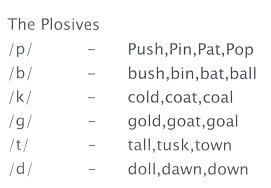English Pronunciation : The PlosivesEnglish Pronunciation Index
In English there are six plosives : three voiceless and three voiced. It happens that in English the voiceless plosives are normally aspirated, while the voiced plosives are not. Therefore, we have to add the letter h to the symbols used for the voiceless plosives, but not for the voiced plosives. This distribution of voicing and aspiration is not universal. The classic example to the contrary is Sanskrit and its modern descendents in India where all four combinations of voiceless/voiced versus aspirated/unaspirated occur. In French and Italian there is much less aspiration in the voiceless plosives than in English. In other languages there are additional plosives at different places of articulation, such as palatal and uvular plosives. Moreover, phonemes equivalent to English plosives may be made at different places of articulation; for example, /th/ is a dental plosive rather than an alveolar plosive in many languages.
The six English plosives can be subdivided into a voiceless-voiced pair at each of three places of articulation.

From The Plosives to HOME PAGE
|